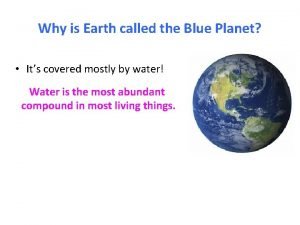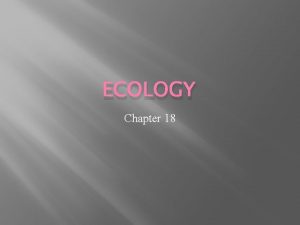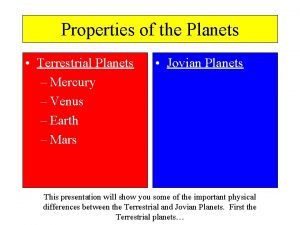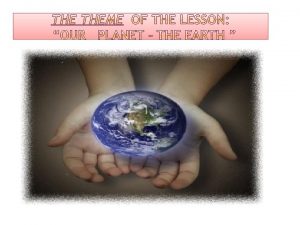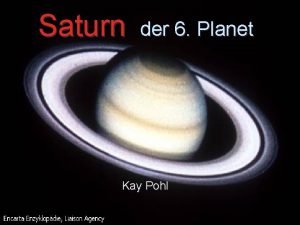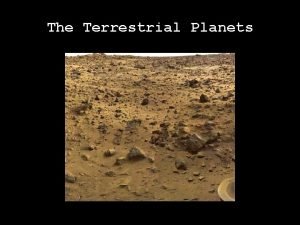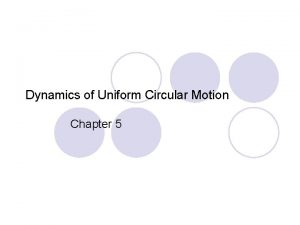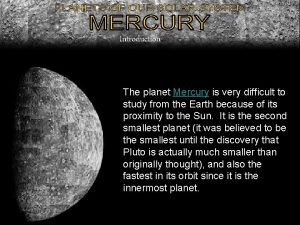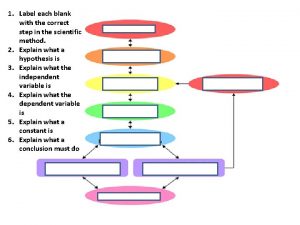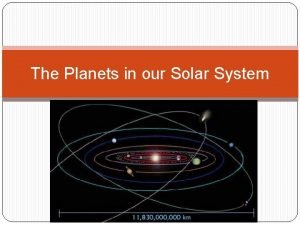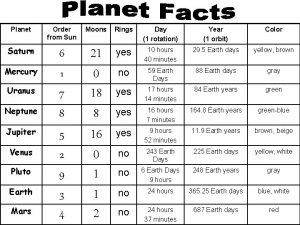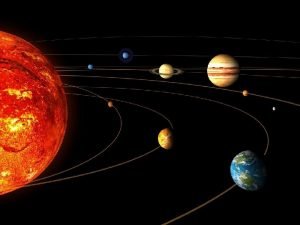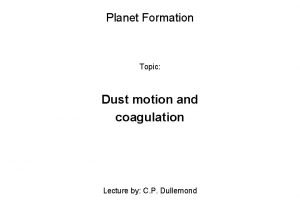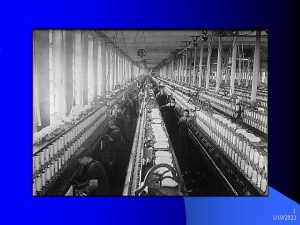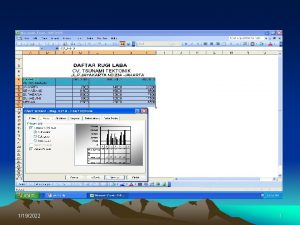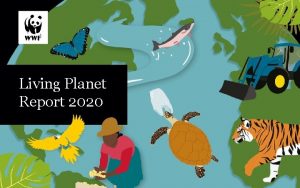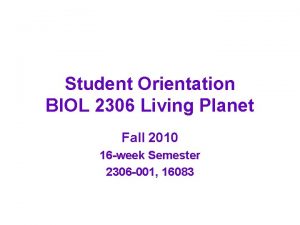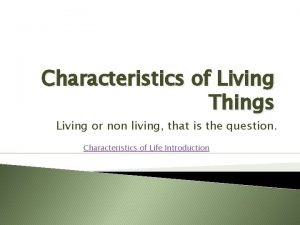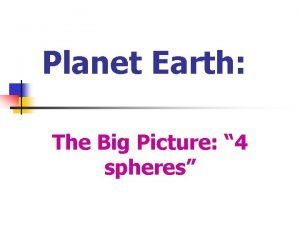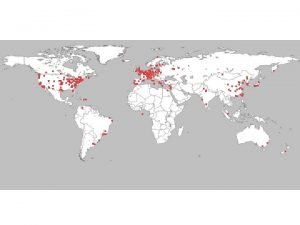Living Planet 2010 1192022 3 1192022 4 1192022

































![Plants and carbon dioxide • Variations beneath a canopy • Carbon dioxide [ ] Plants and carbon dioxide • Variations beneath a canopy • Carbon dioxide [ ]](https://slidetodoc.com/presentation_image_h2/7fb8f9741f8b172b9bcafbdb6baa4e38/image-34.jpg)

- Slides: 35


Living Planet 2010

1/19/2022 3

1/19/2022 4

1/19/2022 5

Responses by sedentary organisms • Plants, aquatic invertebrates • In all (except equatorial environments), physical conditions follow a seasonal cycle • Morphological and physiological characteristics must change accordingly 1/19/2022 6

Animal responses to environmental temperatures • Most species of animals are, like plants, ectotherms: rely on external sources of heat to determine their pace of metabolism – Fish, amphibians and lizards • Others – endotherms: regulate their body temperature by producing heat within their body – Mainly birds and mammals 1/19/2022 7

Organisms maintain a constant internal environment. • An organism’s ability to maintain constant internal conditions in the face of a varying environment is called homeostasis: – homeostatic systems consist of sensors, effectors, and a condition maintained constant – all homeostatic systems employ negative feedback -- when the system deviates from set point, various responses are activated to return system to set point 1/19/2022 8

Negative system 1/19/2022 feedback 9

Temperature Regulation: an Example of Homeostasis • Principal classes of regulation: – homeotherms (warm-blooded animals) - maintain relatively constant internal temperatures – poikilotherms (cold-blooded animals) - tend to conform to external temperatures • some poikilotherms can regulate internal temperatures behaviorally, and are thus considered ectotherms, while homeotherms are endotherms 1/19/2022 10

Homeostasis is costly. • As the difference between internal and external conditions increases, the cost of maintaining constant internal conditions increases dramatically: – in homeotherms, the metabolic rate required to maintain temperature is directly proportional to the difference between ambient and internal temperatures 1/19/2022 11

Limits to Homeothermy • Homeotherms are limited in the extent to which they can maintain conditions different from those in their surroundings: – beyond some level of difference between ambient and internal, organism’s capacity to return internal conditions to norm is exceeded – available energy may also be limiting, because regulation requires substantial energy output 1/19/2022 12

Partial Homeostasis • Some animals (and plants!) may only be homeothermic at certain times or in certain tissues… • pythons maintain high temperatures when incubating eggs • large fish may warm muscles or brain • some moths and bees undergo pre-flight warm-up • hummingbirds may reduce body temperature at night (torpor) 1/19/2022 13

Hummingbirds maintain a constant low body temp when in torpor 1/19/2022 14

Plant resources

• Resources may be either biotic or abiotic components of the environment • Organisms that are fixed and ‘rooted’ in position cannot search for food; must grow toward their resources – like a shoot or a root – or catch resources that move to them • Green plants depend on: – Energy that radiates to them – Atmospheric carbon dioxide that diffuses to them – Mineral cations that they obtain from soil colloids in exchange for hydrogen ions – Water and dissolved anions that the roots absorb from the soil 1/19/2022 16

Solar radiation • Green plants use only ~ 44% of that narrow part of the spectrum of solar radiation that is visible to us between infrared and ultraviolet • Rate of photosynthesis increases with intensity of radiation that a leaf receives – but with diminishing returns. What does that mean? 1/19/2022 17

Response of photosynthesis by leaves of various types of green plants 1/19/2022 18

Solar radiation • Sun and shade plants and sun and shade leaves • Photoinhibition of photosynthesis – rate of fixation of carbon decreases with increasing radiation intensity – High radiation overheating • Solar radiation – dynamic – Angle and intensity change – diurnally; cloud cover; leaf shadowing 1/19/2022 19

1/19/2022 20

water • Most plant parts are largely composed of water; as much as 98% of soft leaves; minute fraction of water that passes through plant • Wilting if rate of uptake falls below rate of release, body of plant starts to dry out; cells lose turgidity; plant wilts 1/19/2022 21

Moving Water from Roots to Leaves • Once water is in root cells, then what? – water moving to the top of any plant must overcome tremendous forces caused by gravity and friction in conducting elements (xylem): • opposing force is generated by evaporation of water from leaf cells to atmosphere (transpiration) • water potential of air is typically highly negative (potential of dry air at 20 o. C is -1, 332 atm) • force generated in leaves is transmitted to roots -- water is drawn to the top of the plant (tension-cohesion theory) 1/19/2022 22

Water potential that moves water from the roots to the leaves of a plant is generated by transpiration 1/19/2022 23

Plants and water • Species of green plants differ in who they survive dry environments • Avoiders: desert annuals, annual weeds, and most crop plants – Short lifespan; photosynethetic activity [ ] during periods when + balance; otherwise dormant as seeds or shed their leaves • Tolerators: produce long-lived leaves that transpire slowly – Tolerate drought; slower photosynthesis 1/19/2022 24

Adaptations to Arid Environments • Most water exits the plant as water vapor through leaf openings called stomates: – plants of arid regions must conserve limited water while still acquiring CO 2 from the atmosphere (also via stomates) - a dilemma! • potential gradient for CO 2 entering plant is substantially less than that for water exiting the plant • heat increases the differential between internal and external water potentials, making matters worse 1/19/2022 25

Adaptations to Arid Environments • Numerous structural adaptations address challenges facing plants of arid regions by: – reducing heat loading: • increase surface area for convective heat dissipation • increase reflectivity and boundary layer effect with dense hairs and spines – reducing evaporative losses: • protect surfaces with thick, waxy cuticle • recess stomates in pits, sometimes also hair-filled 1/19/2022 26

Spines and hairs help plants adapt to heat and drought. (a) cross section; (b) surface view of the leaf of the desert perennial herb 1/19/2022 27

This drought-resistant plant reduces water loss by placing its stomates in hair-filled pits on the leaf’s undersurface 1/19/2022 28

Leaves of desert plants: adaptations These 3 species from the Sonoran Desert in Arizona all have adaptations that help them cope w/ hot, dry conditions 1/19/2022 29

Plants and heat • Evaporation of water lowers temperature of body • If plants are prevented from transpiring – they may overheat; die from heat • Example: desert honeysweet – grows strongly; leaves killed if temp reaches 50 C; – Transpiration cools leaf surface to a 40 -45 C – How? 1/19/2022 30

Water and Salt Balance in Terrestrial Plants • Plants take up excessive salts along with water, especially in saline soils. – plants must actively pump salts back into soil • In coastal mudflats, mangroves must acquire water while excluding salts. They: – establish high root osmotic concentrations to maintain water movement into root – exclude salts at the roots and also excrete excessive salts from specialized leaf glands 1/19/2022 31

Mangrove plants have adaptations for coping with a high salt load. (a) roots immersed in salt water at high tide; (b) specialized glands in the leaves excrete salt 1/19/2022 32

Plants and Mineral nutrients • Roots: extract water and minerals from soil – N, P, S, K, Ca, Mg, and Fe – Traces of Mn, Zn, Cu, and B – All from the soil • Root architecture – Foraging efficiency 1/19/2022 33
![Plants and carbon dioxide Variations beneath a canopy Carbon dioxide Plants and carbon dioxide • Variations beneath a canopy • Carbon dioxide [ ]](https://slidetodoc.com/presentation_image_h2/7fb8f9741f8b172b9bcafbdb6baa4e38/image-34.jpg)
Plants and carbon dioxide • Variations beneath a canopy • Carbon dioxide [ ] is highest very close to the ground in the summer – where it is released rapidly from decomposing organic matter in the soil • Daytime photosynthesizing plants: actively remove CO 2 from the air; night [ ] increase as plants respire • Winter: low temperatures rates of photosynthesis, respiration, and decomposition – all slow • Aquatic environments: variations in CO [ ] highest when water mixing is limited – Summer: layers of warm water towards the surface and colder, carbon -dioxide rich layers beneath 1/19/2022 34

Carbon cycle 1/19/2022 35
 Why the earth is called blue planet
Why the earth is called blue planet Studying our living planet
Studying our living planet Is it living
Is it living Living non living dead
Living non living dead What is the smallest living unit
What is the smallest living unit Blue things
Blue things The terrestrial planet
The terrestrial planet Cost of planet fitness membership
Cost of planet fitness membership The earth is my home i promise to keep it lyrics
The earth is my home i promise to keep it lyrics Kids planet sale
Kids planet sale Pluto planta
Pluto planta Things we can do to protect the environment
Things we can do to protect the environment Planet kay
Planet kay Ibm smarter planet strategy
Ibm smarter planet strategy Xena planet
Xena planet Planet.com.tw
Planet.com.tw What colour is venus
What colour is venus Planet fitness internship
Planet fitness internship On a planet
On a planet Introduction to mercury
Introduction to mercury Happy planet index
Happy planet index One planet food
One planet food The first four planets
The first four planets Label each planet
Label each planet Jovian planet
Jovian planet Neptune
Neptune What's your favorite planet
What's your favorite planet Planet.com.tw
Planet.com.tw Planet beruf de
Planet beruf de Planet.com.tw
Planet.com.tw Planet usb wifi adapter driver
Planet usb wifi adapter driver Planet project template
Planet project template Solar system picture
Solar system picture Inside pluto planet
Inside pluto planet Planet formation
Planet formation Matching planet rings
Matching planet rings
